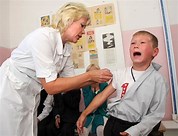Vitamin D and the Flu
 There is a lot more in that needle than the vaccine
There is a lot more in that needle than the vaccineFlu Shot Facts vs. Vit D Facts
(psst, spoiler… Vit D is better….just sayin’ “)
A systematic review of 51 studies involving 260,000 children age 6 to 23 months found no evidence that the flu vaccine is any more effective than a placebo in that group (Cochrane Database Syst Rev. 2006;1:CD004879).
A JAMA study showed the incidence of clinical influenza in the vaccinated group was 2%, but in the un-vaccinated group it was only 3% (JAMA 1994;272:1661-5). This means that out of 100 people, one person was attributed with avoiding the flu because of the vaccine.
Officials select three strains of flu virus for the vaccine that they think are most likely to be circulating during the next winter season (they failed to pick the swine flu last year).
According to the CDC, common substances found in flu vaccines include: Antibiotics, MSG, Formaldehyde, mercury-containing Thimerosal, and Polysorbate 80 (PS 80 can cause severe anaphylactoid reactions – Ann Asthma Immunol 2005 Dec 95(6):593-9.)
There are 1 to 2 cases of Guillain-Barré syndrome per 1 million vaccinated persons. Taking a flu shot is essentially the same as buying a lottery ticket for acquiring GBS, anti-inflammatory demyelinating condition of the nervous system.
Pneumonia Kills Seniors More than Flu
>70 age group accounts for 3/4 of all flu deaths are mostly from bacterial pneumonia not the flu virus. In the largest case-control study of flu vaccine in the elderly, the Group Health study (The Lancet, August 2, 2008) found the “flu vaccine doesn’t protect seniors as much as has been thought,” as it does not protect from pneumonia.
Vitamin D Facts
From: Epidemic Influenza and Vitamin
D. Epidemiology and Infection; Oct. 2007; 135 (7):1095-1098; On the Epidemiology of Influenza. Virology Journal; Feb. 25, 2008, vol 5
Compelling evidence indicates vitamin D deficiency is the ‘seasonal stimulus’ responsible for flu outbreaks”.
“Physiological doses (800-2,000 IU/day) of vitamin D prevent many viral infections”, and “Vitamin D is the ‘antibiotic vitamin’ due primarily to its robust effects on innate immunity”.
Double-blind, randomized, placebo-controlled trial: 104 women given vitamin D were 3 times less likely to report cold and flu symptoms. “A low dose (800 IU/day) not only reduced incidence, it abolished the seasonality of reported colds and flu.
A higher dose (2,000 IU/day), given during the last year of their trial, virtually eradicated all reports of cold or flu”.
Vitamin D deficiency predisposes children to respiratory infections, and an interventional study showed vitamin D reduces the incidence.